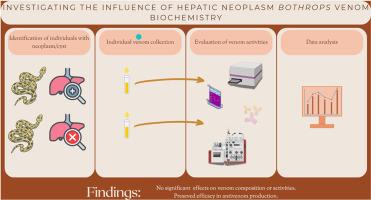肝脏肿瘤对肉毒蛇毒生物化学影响的研究。
IF 2.4
4区 医学
Q2 PHARMACOLOGY & PHARMACY
引用次数: 0
摘要
蛇中毒是一个相关的公共卫生问题,特别是在世界各地的热带地区。Bothrops毒液对巴西的抗蛇毒血清生产至关重要;然而,肝肿瘤对毒液成分的影响仍未被探索。本研究旨在评估肝脏肿瘤和/或囊肿是否影响五种Bothrops物种毒液的生化特征和酶活性。采用SDS-PAGE、Western blotting、ELISA、RP-HPLC和酶活性测定分析了17条蛇的毒液,其中8条有肝脏病变,9条健康。结果显示了高度的种内和种间变异性,没有一致的模式将肿瘤的存在与毒液蛋白质组成或酶活性的显著变化联系起来。某些个体在蛋白水解、磷脂酶A2、l -氨基酸氧化酶活性和最小凝血剂量方面存在偶发性差异;然而,这些都不能直接归因于肝脏病理。商业抗蛇毒血清的免疫反应性在所有样品中都有效。该研究得出结论,肝肿瘤或囊肿不会损害抗蛇毒血清生产的毒液生化完整性,从而加强了出于公共卫生目的,利用这些个体进行圈养毒液提取的可行性。本文章由计算机程序翻译,如有差异,请以英文原文为准。

Investigating the influence of hepatic neoplasms on Bothrops venom biochemistry
Snake envenoming is a relevant public health issue, especially in tropical regions worldwide. Bothrops venom is essential for antivenom production in Brazil; however, the impacts of hepatic neoplasms on venom composition remain unexplored. This study aimed to evaluate whether hepatic neoplasms and/or cysts influence the biochemical profile and enzymatic activity of venoms from five Bothrops species. Venoms from 17 snakes — 8 with hepatic alterations and 9 healthy — were analyzed using SDS-PAGE, Western blotting, ELISA, RP-HPLC, and enzymatic activity assays. The results revealed high intra- and interspecific variability, with no consistent pattern linking the presence of neoplasms to significant changes in venom protein composition or enzymatic activities. Occasional differences were observed in proteolytic, phospholipase A2, L-amino acid oxidase activities and Minimum Coagulant Dose in some individuals; however, these were not directly attributable to hepatic pathology. Immunoreactivity with the commercial antibothropic antivenom remained effective in all samples. The study concludes that hepatic neoplasms or cysts do not compromise venom biochemical integrity for antivenom production, reinforcing the viability of using these individuals for venom extraction in captivity for public health purposes.
求助全文
通过发布文献求助,成功后即可免费获取论文全文。
去求助
来源期刊

Toxicon
医学-毒理学
CiteScore
4.80
自引率
10.70%
发文量
358
审稿时长
68 days
期刊介绍:
Toxicon has an open access mirror Toxicon: X, sharing the same aims and scope, editorial team, submission system and rigorous peer review. An introductory offer Toxicon: X - full waiver of the Open Access fee.
Toxicon''s "aims and scope" are to publish:
-articles containing the results of original research on problems related to toxins derived from animals, plants and microorganisms
-papers on novel findings related to the chemical, pharmacological, toxicological, and immunological properties of natural toxins
-molecular biological studies of toxins and other genes from poisonous and venomous organisms that advance understanding of the role or function of toxins
-clinical observations on poisoning and envenoming where a new therapeutic principle has been proposed or a decidedly superior clinical result has been obtained.
-material on the use of toxins as tools in studying biological processes and material on subjects related to venom and antivenom problems.
-articles on the translational application of toxins, for example as drugs and insecticides
-epidemiological studies on envenoming or poisoning, so long as they highlight a previously unrecognised medical problem or provide insight into the prevention or medical treatment of envenoming or poisoning. Retrospective surveys of hospital records, especially those lacking species identification, will not be considered for publication. Properly designed prospective community-based surveys are strongly encouraged.
-articles describing well-known activities of venoms, such as antibacterial, anticancer, and analgesic activities of arachnid venoms, without any attempt to define the mechanism of action or purify the active component, will not be considered for publication in Toxicon.
-review articles on problems related to toxinology.
To encourage the exchange of ideas, sections of the journal may be devoted to Short Communications, Letters to the Editor and activities of the affiliated societies.
 求助内容:
求助内容: 应助结果提醒方式:
应助结果提醒方式:


